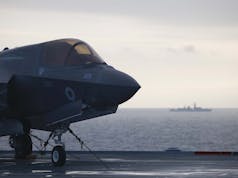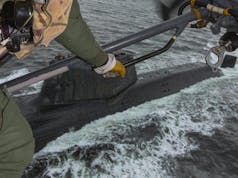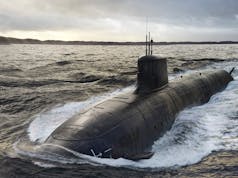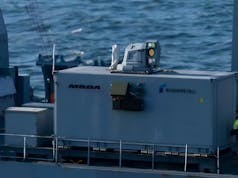The replacement for HMSML Gleaner has been confirmed as one of the series of new workboats announced earlier this month in a £48 million contract.
Cork based shipyard Safehaven Marine will be constructing the vessel, the largest in the new workboat fleet, based off their proven Wildcat 60 design. These 18m catamarans have a loaded displacement around 37 tonnes with a capacity for up to twelve-crew to be berthed onboard, and an endurance of seven days. They are capable of deploying a range of sonar options and are all weather capable.
Vessels from the Wildcat series, which come in a range of sizes and models, are already serving a variety of government and commercial organisations across the globe including the Kuwait Institute of Scientific Research, the Geological Survey of Ireland and the Port of Liverpool and Manchester Shipping Canal.
With an overall length of 18m the new vessel is larger than the existing Gleaner, currently the Royal Navy’s smallest commissioned vessel and will see that title pass onto the fast patrol boats HM Ships Scimitar and Sabre of the Gibraltar Squadron.
The Survey Motor Launch role may not be one of the navy’s more glamorous duties but has proven invaluable in recent years. As well as routine work updating charts and records around British coastal waters, HMS Gleaner has been extensively involved in preparations for the new Queen Elizabeth class aircraft carriers. This included surveys to ascertain the success of dredging works in the Firth of Forth and entrance to Portsmouth harbour.
The new workboat fleet will comprise a variety of small vessels to support fleet operations across the globe and will include the vessels to be embarked aboard the new aircraft carriers. Roles will include dive training, officer training and passenger transport as well as survey duties. The modular design will allow the vessels to change roles quickly as needs dictate. At least thirty-three vessels will be built under the current contract with options for five more available.
It is unclear at this stage if the new workboat will be formally commissioned as a naval vessel, if so it would be notable as the first commissioned Royal Navy vessel to be built in Ireland since its independence.
HMSML Gleaner is due to be decommissioned in December of this year after thirty-four years’ service, her replacement will enter service in May 2018.













I genuinely feel this is a missed opportunity really.
I would have preferred a standard size for the Atlas fleet and would’ve like to have seen the introduction of some Safeboats Mk6 into the fleet – at 26m long they are a bit meatier than what is being proposed but at circa £5m each I think they offer real value.
I think the small ships fleet is as important as the capital assets as if we are to transition to a leaner, meaner escort led fleet then these smaller assets need to be bought to provide remote capabilities and volume to conduct asymmetric warfare.
For me the following 3 platforms are crucial:
Atlas Arcims for MCM/MHVC (£1-2m each)
Safeboats Mk 6 – Fast Patrol and survey(£5m each)
CB90 – Attack boats (£2m each)
ideally I would like to see these designed and built in standard sizes so that 2 atlas can be replaced by a single CB90 in the mission/stern bay of an escort or mothership and for a Mk6 to be able to deploy an Atlas from its stern as well.
Standardisaton of machinery across all would also be very useful from a parts and training perspective.
I don’t understand the reasoning and logic as to why this vessel is being built abroad by a foreign company when we have a wealth of shipyards able to build this vessel.
Exactly. If the argument is that it is more expensive for it to be done at home, then the government should be taking measures to lower those costs. Like, for instance, implementing a certain ship building strategy they have been ignoring for months.
To be fair chaps we are a trading nation and the Irish navy has bought 3 frigates from appledore dockyard so it’s a fair exchange and having seen these boats in action I can see why they would want one like it.
Let’s keep a sense of proportion over this. All but one of the 38 new workboats are being built in the UK.
And the Irish government did recently buy 3 OPV’s from the UK.
All the boats have modular, interchangeable design from a baseline configuration so they can change roles when needed.
There’s an impression of knees getting jerked on a regular basis around here when I read some comments.
@Jack regarding your ‘knees getting jerked’ I would have to agree.
Some posts seem as if their posters were determined to find something – anything – to object to. The news about the workboat construction is very welcome indeed. As for the Irish yard winning the contract to build one of the vessels – good for them. As you and other have said, trade goes both ways.
Best Tim
Considering the Irish have ordered 6 OPVs (2 Roisins and 4 Sam Becketts) since the 1990s, all from Appledore, and also have 2 ex-RN vessels (the net result of which is once the next ship due out of service goes they will have an entirely UK-built fleet), it is hardly unreasonable for a small survey vessel to be built there.
So w can replace the smallest serving vessel in the Royal Navy very easily- what about doing something about returning back to the required 26-30 high-end frigate and destroyer fleet the Royal Navy needs to just meet current commitments?
Anyone out there seriously believe that anything is going to change anytime soon- no political will to sort out the dire mess the Royal Navy is in currently.
I had hoped with the QE about to enter service that we would rebuild our navy around the 2 QE class carriers- does not appear to be the case.
Just sad how we have let the Royal Navy and to a lesser extent the other armed forces get into this situation via repeated ill thought out defence cuts and capability gaps.